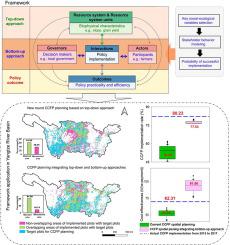当前位置:
X-MOL 学术
›
Engineering
›
论文详情
Our official English website, www.x-mol.net, welcomes your feedback! (Note: you will need to create a separate account there.)
Integrating Top-Down and Bottom-Up Approaches Improves Practicality and Efficiency of Large-Scale Ecological Restoration Planning: Insights from a Social–Ecological System
Engineering ( IF 12.8 ) Pub Date : 2022-09-14 , DOI: 10.1016/j.eng.2022.08.008 Zhaowei Ding , Hua Zheng , Jun Wang , Patrick O'Connor , Cong Li , Xiaodong Chen , Ruonan Li , Zhiyun Ouyang
Engineering ( IF 12.8 ) Pub Date : 2022-09-14 , DOI: 10.1016/j.eng.2022.08.008 Zhaowei Ding , Hua Zheng , Jun Wang , Patrick O'Connor , Cong Li , Xiaodong Chen , Ruonan Li , Zhiyun Ouyang

|
Ecological restoration policies and their implementation are influenced by ecological and socioeconomic drivers. Top-down approach-based spatial planning, emphasizing hierarchical control within government structures, and without a comprehensive consideration of social–ecological interactions may result in implementation failure and low efficiency. Although many researchers have indicated the necessity to engage social–ecological interactions between stakeholders in effective planning processes, socioeconomic drivers of ecological restoration on a large scale are difficult to quantify because of data scarcity and knowledge limitations. Here, we established a new ecological restoration planning approach linking a social–ecological system framework to large-scale ecological restoration planning. The new spatial planning approach integrates bottom-up approaches targeting stakeholder interests and provides social considerations for stakeholder behavior analysis. Based on this approach, a meta-analysis is introduced to recognize key socioeconomic and social–ecological factors influencing large-scale ecological restoration implementation, and a stochastic model is constructed to analyze the impact of socioeconomic drivers on the behavior of authorities and participants on a large scale. We used the Yangtze River Basin-based Conversion of Cropland to Forest Program (CCFP), one of the largest payments for ecosystem service programs worldwide, to quantify the socioeconomic impacts of large-scale ecological restoration programs. Current CCFP planning without socioeconomic considerations failed to achieve large-scale program goals and showed low investment efficiency, with 19.71% of the implemented area reconverting to cropland after contract expiry. In contrast, spatial matching between planned and actual restoration increased from 61.55% to 81.86% when socioeconomic drivers were included. In addition, compared to that with the current CCFP implementation, the cost effectiveness of spatial planning with social considerations improved by 46.94%. Thus, spatial optimization planning that integrates both top-down and bottom-up approaches can result in more practical and effective ecological restoration than top-down approaches alone. Our new approach incorporates socioeconomic factors into large-scale ecological restoration planning with high practicality and efficiency.
中文翻译:

整合自上而下和自下而上的方法提高了大规模生态恢复规划的实用性和效率:来自社会生态系统的见解
生态恢复政策及其实施受到生态和社会经济驱动因素的影响。自上而下的空间规划,强调政府内部的层级控制,没有综合考虑社会与生态的相互作用,可能会导致实施失败和效率低下。尽管许多研究人员指出,有必要在有效的规划过程中让利益相关者之间进行社会生态互动,但由于数据稀缺和知识有限,大规模生态恢复的社会经济驱动因素很难量化。在这里,我们建立了一种新的生态恢复规划方法,将社会生态系统框架与大规模生态恢复规划联系起来。新的空间规划方法整合了针对利益相关者利益的自下而上的方法,并为利益相关者行为分析提供了社会考虑。基于这种方法,引入荟萃分析来识别影响大规模生态恢复实施的关键社会经济和社会生态因素,并构建随机模型来分析社会经济驱动因素对当局和参与者行为的影响规模大。我们利用长江流域退耕还林计划(CCFP)来量化大规模生态恢复计划的社会经济影响,该计划是全球生态系统服务计划中最大的支付项目之一。目前的CCFP规划没有考虑社会经济因素,未能实现大规模的项目目标,投资效率低下,合同期满后19.71%的实施面积恢复为耕地。相比之下,当纳入社会经济驱动因素时,计划恢复与实际恢复之间的空间匹配度从 61.55% 增加到 81.86%。此外,与当前CCFP实施相比,考虑社会因素的空间规划成本效益提高了46.94%。因此,结合自上而下和自下而上方法的空间优化规划可以比单独自上而下的方法更实际和有效的生态恢复。我们的新方法将社会经济因素纳入大规模的生态恢复规划中,具有很高的实用性和效率。
更新日期:2022-09-14
中文翻译:

整合自上而下和自下而上的方法提高了大规模生态恢复规划的实用性和效率:来自社会生态系统的见解
生态恢复政策及其实施受到生态和社会经济驱动因素的影响。自上而下的空间规划,强调政府内部的层级控制,没有综合考虑社会与生态的相互作用,可能会导致实施失败和效率低下。尽管许多研究人员指出,有必要在有效的规划过程中让利益相关者之间进行社会生态互动,但由于数据稀缺和知识有限,大规模生态恢复的社会经济驱动因素很难量化。在这里,我们建立了一种新的生态恢复规划方法,将社会生态系统框架与大规模生态恢复规划联系起来。新的空间规划方法整合了针对利益相关者利益的自下而上的方法,并为利益相关者行为分析提供了社会考虑。基于这种方法,引入荟萃分析来识别影响大规模生态恢复实施的关键社会经济和社会生态因素,并构建随机模型来分析社会经济驱动因素对当局和参与者行为的影响规模大。我们利用长江流域退耕还林计划(CCFP)来量化大规模生态恢复计划的社会经济影响,该计划是全球生态系统服务计划中最大的支付项目之一。目前的CCFP规划没有考虑社会经济因素,未能实现大规模的项目目标,投资效率低下,合同期满后19.71%的实施面积恢复为耕地。相比之下,当纳入社会经济驱动因素时,计划恢复与实际恢复之间的空间匹配度从 61.55% 增加到 81.86%。此外,与当前CCFP实施相比,考虑社会因素的空间规划成本效益提高了46.94%。因此,结合自上而下和自下而上方法的空间优化规划可以比单独自上而下的方法更实际和有效的生态恢复。我们的新方法将社会经济因素纳入大规模的生态恢复规划中,具有很高的实用性和效率。


























 京公网安备 11010802027423号
京公网安备 11010802027423号